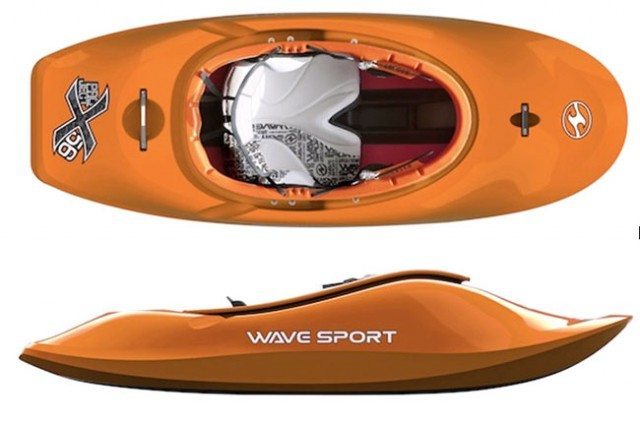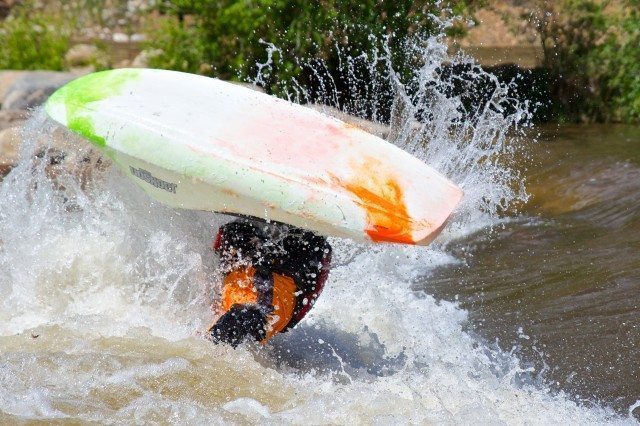In his Boats 101: River Runners and Creek Boats, Blister’s Tom Neilson discussed boats that are designed to move downstream quickly, tackle challenging whitewater, and provide a stable ride. He also defined terms such as rocker, edge profile, and hull shape that will be used throughout this article. If you’re looking for in-depth definitions, refer back to the first 101 piece.
This article covers whitewater kayaks designed to surf waves, squirt in eddylines, and perform freestyle tricks like “space godzillas” and “macho moves.” Freestyle boat designs have evolved dramatically in the last several years, and knowing how various features affect performance will help you choose the boat that’s right for you.
Types of Playboats
We’ll be talking about two categories of playboats. Freestyle kayaks are boats designed specifically for surfing waves and performing tricks. They can be used to run rivers, but that’s not their strength.

Play Runners are typically slightly longer than freestyle kayaks, and they’re better at (more stable) traveling downstream. Although they can still surf waves and perform tricks, their length, plus a few other key design aspects, gives these boats a more forgiving downstream ride—at the expense of freestyle performance.

(If you don’t think either freestyle kayaks or play runners fit your whitewater goals, see Tom Neilson’s article on river runners and creek boats).
A Quick Note on Terminology
This terminology can get confusing since “playboat” is often used to describe both freestyle kayaks and play runners. But using the blanket term doesn’t capture the design differences between these two categories of boats. For example, freestyle kayaks like the Jackson Rock Star or Wavesport Project X differ from play runners like the Jackson Fun or Liquidlogic Freeride, but all four technically fit under the playboat umbrella.
That’s why in our reviews at Blister, we try to be very precise when referring to and differentiating between different types of playboats. We separate play runners from river runners, and we’ll always refer to playboats as either freestyle kayaks or play runners. You’ll read why in a minute.
Design
Freestyle boats and play runners share several design features, including progressive rocker profiles, planing hulls, and hard edges.
But that’s where the similarities end. The boats typically differ in length, volume distribution, and edge profile. Play runners optimize stability—they’re usually longer, have evenly distributed volume, and a thinner bow and stern. Modern freestyle kayaks are typically very short with a lot of volume to give the paddler more buoyancy for certain tricks.
- Rocker
First up in our discussion of design: rocker. Rocker is the degree of curvature in the hull from bow to stern. Playboats, both freestyle kayaks and play runners, used to feature either continuous rocker or kick rocker.
Now most playboat designers favor very gradual continuous rocker profiles. Continuous rocker gives the paddler a “looser,” more responsive feel on a wave, meaning spins are easier to pull off. This type of rocker is stabler during tricks, more forgiving when running rivers, and gives the paddler more speed down the face of a wave.

Kick rocker, on the other hand, tends to make boats slower when surfing a wave (at least in my experience), and it forces designers to include a very long edge profile that made boats less responsive on waves.
Although this distinction shouldn’t be much of an issue if you’re buying a brand new boat, it could come into play if you’re looking at used ones.

Rocker can also be either linear/gradual or progressive. In a progressive rocker profile, the rate of curvature increases toward the end of the boat, similar to kick rocker. On the linear or gradual profile, the rate of curve stays almost constant throughout the length of rocker.
Modern playboats generally feature a linear rocker profile with very little kick at the end. This kind of rocker allows for short freestyle kayaks that are still fast when planing on a wave.
- Hulls and Edges
Whitewater kayaks typically have either a planing hull or a displacement hull. Like a surfboard, a planing hull is almost flat from edge to edge. A displacement hull is rounded. Although creek boats and river runners have a variety of hulls, freestyle kayaks and play runners pretty much always have a planing hull since it’s best for surfing holes and waves.
This planing hull can be combined with different types of edges, which vary from hard to soft, depending on what the boat will be used for. Play runners typically have a softer edge, which makes them easier to roll and less “grabby” when entering and exiting eddies. Combining a planing hull with soft edges in a play runner makes for a more forgiving ride for less aggressive playboaters.
Hard edges on an aggressive freestyle boat let paddlers lay down hard carves and perform maneuvers that help them pop into the air off of a wave. But an edge that is too hard can make moves like flat spins and controlled carves difficult.
To combat this problem, some boat manufacturers make playboats with a “double edge.” This typically includes a soft edge plus a harder secondary edge that can be engaged when the paddler wants to lay down a hard carve or edge transfer on a wave or when entering an eddy.

- Length
Freestyle boats are shorter than play runners, letting freestyle boaters plug their bows deep into the a hole for aerial moves. The shorter boats also have less swing weight since the weight of the boat is closer to the paddler (the fulcrum of the spin in any trick.)
Although this is extremely appealing to aggressive paddlers, it has some downsides. Because of the short bow and stern, it is easy to bury your bow when paddling downstream quickly. It also makes it a bit too easy for paddlers to sink their stern and catch an edge, especially when coming in and out of eddies.
On top of that, the short stern can make rolling harder since coming up on your back deck—a fairly common rolling strategy—will significantly destabilize you. Finally, while the low spin weight of the modern freestyle kayak makes top-end tricks like McNasties and airscrews easier, it can make classic moves like the cartwheel and stern squirt more difficult since the boat rotates so fast it’s hard for a paddler to keep up.
So while the short length is great for advanced and aggressive paddlers, or those hoping to perfect their technique, it can be a daunting challenge for beginners or for those looking to relax a bit more on the river.
This is where the longer play runners come in handy. The added length solves most of the problems mentioned above while only sacrificing a little bit of trick performance on the wave.
